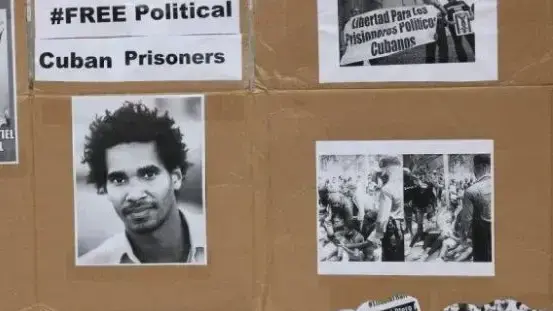Dictatorship Said to Want Silence or Exile
Trump Flap ‘Inconsequential’ to NABJ Bottom Line
South Asian Journalists Group Celebrates Its 30th
Harris Blitzes Media, but Some Still Not Satisfied
Obama Talk Elevates Coverage of Black Male Vote
Someone Noticed: Hurricanes Will Affect Black Vote
Stories Reveal How Problem Cops Are Simply Shifted
More Than 1,000 Have Died by Wrongful Use of Force
Coates Draws SRO Crowd to New York’s Apollo
No Accountability for Journalist Deaths in Lebanon
Warren Wilson, Pioneering L.A. Journalist, Dies at 90
Short Takes: Kathy Chaney; Anthony Wilson; racism increases suicide risk; Indigenous People’s Day; Tony Marcano; Errol Louis; delayed justice in Peru; protecting female journalist victims of violence; reporting on president’s health forbidden; Voice of America suspended.
South Asian Journalists at 30: Relatively Small, but Diverse, Network-Ready, Watchful of Kamala Harris
(Homepage photo: Poster urging release of Cuban political prisoners used in a demonstration in Miami (Photos: Yoandy Castañeda/Diario Las Américas)
Support Journal-ismsDonations are tax-deductible.
“Yeris Curbelo Aguilera, who reported on a protest . . . for the independent news outlet Palenque Visión in May last year, was sentenced to two years in prison on Sept. 24,” Nora Gámez Torres reported Oct. 4 for the Miami Herald. “In a video released ahead of the trial, Curbelo said he was assaulted by three men believed to work for Cuban state security on Father’s Day. Two of them had assaulted his son months earlier in April. But he was the one facing assault charges in a false case to punish him for his political activism and journalistic work, he said.” (Credit: YouTube, in Spanish)
Dictatorship Said to Want Silence or Exile
The Cuban government has begun to round up independent journalists who do not toe the government line, threatening them with jail and prompting some to leave the country, according to Cuban news sources and the Committee to Protect Journalists.
“These acts come as a new social communication law, which bans independent media outlets in Cuba, went into effect on October 4. The new law was promulgated after anti-government demonstrations swept the island in July 2021, resulting in the prosecution of persons who reported or shared videos of the events online,” the Committee said Friday.
“The Cuban government appears to be engaged in a campaign of harassment and intimidation against the country’s non-state media to force them into silence or exile,” said Katherine Jacobsen, CPJ’s U.S., Canada and Caribbean program coordinator, from Washington. “CPJ calls on the Cuban authorities to respect the rights of journalists to freely express themselves and report the news.”
“Cuban news website El Toque, which operates from exile, reported that the journalists were summoned as part of investigations into accusations that the journalists engaged in ‘mercenary’ activities, including receiving foreign funding in violation of state security. If convicted, the journalists face prison sentences of 4-10 years.
“CPJ confirmed eight cases of journalists being questioned and is investigating more than a dozen others. Four journalists publicly confirmed they were summoned and questioned by Cuban authorities.”
The Cuban Institute for Freedom of Expression and the Press (ICLEP), an advocacy group for independent journalists, said Tuesday that Cuban authorities took action against four of its media directors. It quoted each of the four.
“For her part, Mabel Páez Díaz showed up at the police station at 2:00 p.m. . . . At 3:27 p.m. she was taken to an office for questioning. The officer in charge, who identified himself . . . warned her that they did not want to see ‘a single more bulletin on the street’ and demanded that she abandon social networks, arguing that they already had ‘enough’ to process it. The officer told her threateningly that, ‘she and ICLEP are superfluous in Cuba’ and that, instead of worrying about the organization, you should think more about your child ‘if you didn’t want to drag him with you.’
“In the face of these threats, Mabel firmly replied that her position remained the same as that of three years ago, rejecting intimidation. Despite her response, the officers showed a cynical attitude and they just smiled. The journalist described the interrogation as abrupt and threatening; As one of the officers addressed her, another was silent, staring at her fixed in an attempt at intimidation.
“Mabel left the station with high blood pressure, but reaffirmed her commitment to freedom of the press and to the Cuban people, assuring that her determination continues intact and that she will continue to do journalism. . . .”
She also told her story on Facebook, where she said she was forced to give up money she was paid to attend a training workshop for journalists.
Abraham Jiménez Enoa is an exiled Afro-Cuban journalist and author of “La isla oculta,” a collection of stories of ordinary Cubans living in hardship under the dictatorship. Jiménez, also an honoree of the Committee to Protect Journalists, spoke at the 2023 Oslo Freedom Forum. He messaged Journal-isms from Spain a year ago, reiterating Sunday, that he considers U.S. embargo and the abuses of the dictatorship separate issues: “I am against the U.S. blockade and I am against the Cuban dictatorship. One thing has nothing to do with the other.” (Credit: YouTube)
Some 150 Cuban reporters have gone into exile over the past two years, according to Spain’s El Pais.
CPJ said, “A representative of the Cuban government’s International Press Center (CPI) told CPJ by text message that he recommended investigating whether the U.S. government financed these media outlets and pointed to U.S. law that imposes a public disclosure obligation on persons representing foreign interests. ‘Investigate and you will find Hypocrisy,’ he wrote.”
Cuba, now undergoing an unprecedented economic crisis, has long been ranked near the bottom in assessments of press freedom and human rights.
Human Rights Watch says, “The Cuban government continues to repress dissent and deter public criticism. It routinely relies on long and short-term arbitrary detention to harass and intimidate critics, independent activists, artists, protesters, and others.
“Hundreds of government critics remain behind bars, including many who participated in the landmark July 2021 demonstrations. The US embargo continues to provide the Cuban government with an excuse for its problems, a pretext for its abuses, and a way to garner sympathy abroad with governments that might otherwise have been willing to condemn the country’s repressive practices more vocally.”
 In a separate development, Cuban journalist Javier Díaz (pictured) announced that effective Oct. 6, he was taking over from Mario Vallejo as news presenter at Univisión 23 Miami, after several years in which the latter hosted the weekend editions, CiberCuba reported.
In a separate development, Cuban journalist Javier Díaz (pictured) announced that effective Oct. 6, he was taking over from Mario Vallejo as news presenter at Univisión 23 Miami, after several years in which the latter hosted the weekend editions, CiberCuba reported.
“He also recalled his Cuban roots and encouraged others to fight for their goals: ‘Here you have another Cuban, who left the island like all of you, with a backpack full of dreams. Work and fight for your goals, because living in freedom, anything is possible.’ ”
- Carla Gloria Colomé, El Pais, Spain: The latest attack by the Cuban government against independent journalists: Interrogations, threats, confiscations and exile
- Journal-isms: Coverage of Cuba and free press issues
- Graham Keeley, Voice of America: Cuba Cuts Internet, Surveils Calls of Journalists, Report Finds (Feb. 23)
- Graham Keeley, Voice of America: For Cuban journalists, exile no protection from Havana’s threats (July 29)
- Prisoners Defenders, Spain: New political prisoners keep the number of political prisoners in Cuba at 1,105, who face famine, no medical care and torture (Sept. 16)
- Translating Cuba: The Political Police Harass Independent Journalist José Luis Tan Estrada, Invoking the Social Communication Law
“The Breakdown,” a news show created by the Arizona State University chapter of the National Association of Black Journalists, received a shout-out at NABJ’s board meeting Saturday. It is rare for a student chapter to undertake such an ongoing project, they noted. Shown above is Thursday’s program. (Credit: YouTube)
Trump Flap ‘Inconsequential’ to NABJ Bottom Line
The controversy over Donald Trump’s appearance at the National Association of Black Journalists convention over the summer was “inconsequential” to NABJ’s bottom line, Executive Director Drew Berry told the NABJ board on Saturday.
With 4,336 people in attendance, it was NABJ’s largest convention ever, with 93 percent giving it a favorable assessment in a follow-up survey and the organization taking in $226,296 more than it had budgeted for, Berry said.
The survey, to which 480 people responded, also showed investigative reporting to be the subject matter most wanted by attendees.
That was followed, in order, by management/leadership, health, climate, political/social justice, entrepreneurship and writing. The 480 represented an 11 percent response rate, Berry said.
The Republican presidential candidate’s July 31 appearance drew such headlines as “Trump Says Harris ‘Happened to Turn Black’ in Stunning Slur” (Daily Beast); “Trump insults moderator, questions if Harris is Black in contentious Q&A with Black journalists in Chicago” (Chicago Sun-Times and WBEZ); “Combative Trump Falsely Questions Kamala Harris’ Identity at Black Journalists’ Convention (CNN); ” ‘I Didn’t Know She Was Black’: Donald Trump Questions Kamala Harris’ Race at NABJ Event” (Hollywood Reporter). Many members said his appearance demeaned the organization.
However, NABJ leaders and other members said the organization admirably kept its tradition of inviting all major presidential candidates, regardless of their views. The appearance made news around the world.
The controversy had no financial impact, though a Black movie company did pull out, Berry said. He also said that young journalists now comprised one-third of the membership, including 1,004 students and 502 emerging journalists in their first five years in the field.
Rodney Brooks, finance chair, continued to warn the board that the forces against diversity, equity and inclusion programs continue to make gains that would escalate should the Republicans win the presidency. However, the withdrawal of some corporate DEI programs has not yet affected NABJ, he said.
NABJ President Ken Lemon said he had met with leaders at ABC, CBS, CNN, TNT and The New York Times, and secured commitments for such NABJ projects as its leadership academy.
Much of NABJ’s efforts into 2025 will be in planning its 50th anniversary celebration in Cleveland, with a documentary about the organization expected to be entered into film festivals, hopes that the NABJ founders will receive congressional medals of honor, and other promotion.
The membership preference for instruction in investigative reporting comes as Investigative Reporters & Editors is preparing for its virtual AccessFest Conference Oct. 17-19, targeting journalists of color and “centered on belonging, equity and inclusion – to make us better colleagues in our newsrooms and more well-rounded journalists in our communities.”
At last year’s AccessFest, “At minimum about 44% of our attendees were people of color, but that is an undercount as some don’t provide their data so very likely would be higher, said Francisco Vara-Orta, director of diversity & inclusion.. “Of IRE’s three major conferences, AccessFest sees the largest percentage of BIPOC attendees.”
He added, “Overall, about one-third of our global membership of roughly 5,000 members are people of color. We are the largest professional journalist membership organization. With about 33 percent of those who choose to respond identifying as people of color, IRE’s membership is closer to parity with the national population (which is at 41% as of 2023) than our nation’s newsrooms, according to recent studies that put the national newsroom average at about 20 percent journalists of color.”
Separately, the Center for Journalism & Democracy (CJD) at Howard University introduced this fall “a groundbreaking multi-campus news reporting course” taught simultaneously at seven Historically Black Colleges and Universities (HBCUs).” It is intended to “equip students with the powerful tools of investigative journalism.”
Howard, Morehouse College, North Carolina A&T University, North Carolina Central University, Savannah State University, Texas Southern University and the University of the District of Columbia are participating in the fall, with Florida A&M and Morgan State universities launching their courses in 2025, the university said.
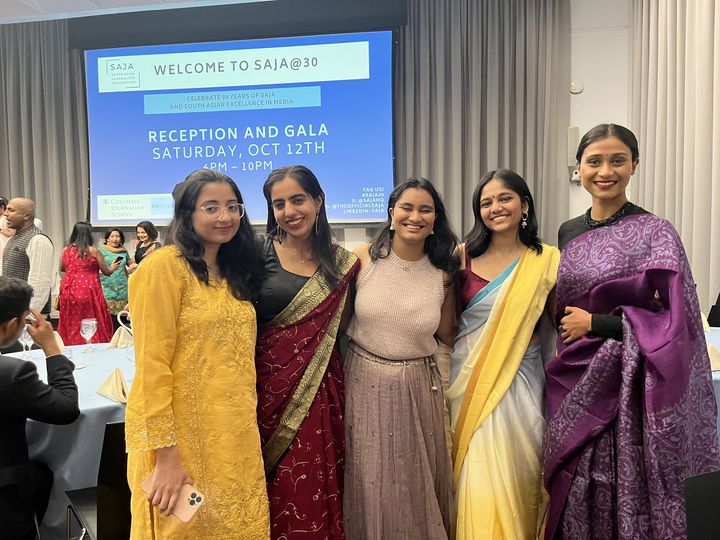
Some members of the South Asian Journalists Association wore South Asian attire for the anniversary event. MSNBC’s Ali Velshi said, “In 2024 what we realize as South Asian journalists, is we are foot soldiers for democracy. We are part of the program. Without us, democracy does not flourish,” he said. (Credit: X)
South Asian Journalists Group Celebrates Its 30th
By Tolu Olasoji
On Saturday evening at Columbia University in New York, the Joseph D. Jamail Lecture Hall buzzed with energy and color as the South Asian Journalists Association (SAJA) celebrated its 30th anniversary. Earlier, the World Room — where Pulitzer Prizes are announced — had hosted a vibrant reception, and now, South Asian journalists and friends, most of whom were resplendent in their sarees, salwar kameez, and kurtas, filled the hall. At the front of the room stood MSNBC’s chief correspondent, Ali Velshi, himself adorned in a kurta, ready to deliver the keynote speech.
As Velshi spoke, he embodied both the evening’s celebratory tone and the weight of the moment. “The one thing we have today that we did not have when SAJA started is people in positions of influence,” Velshi remarked. He highlighted how South Asians, once on the margins, now hold key roles “in news organizations, in universities, in corporations across America.”
“We can have our imprint, where we can actually speak our truth,” he said.
Full story below
“Vice President Harris took questions from undecided Latino voters on Thursday, an unscripted format she used to try to show empathy while making the case that her opponent does not care about the problems of the middle class,” Danielle Kurtzleben and Jason Breslow reported for NPR. (Credit: Univision/YouTube)
Harris Blitzes Media, but Some Still Not Satisfied
- Update: VP Kamala Harris Talks Black Agenda With Roland Martin in North Carolina (YouTube, Oct. 14)
“Vice President Kamala Harris blitzed the media this past week with appearances on CBS’s 60 Minutes, ABC’s The View, The Late Show With Stephen Colbert on NBC, Howard Stern’s SiriusXM radio show, the podcast Call Her Daddy, and a town hall with Univision,” Joan Walsh wrote Friday in The Nation.
“Go back a week or so and we saw her sit down for a one-on-one with MSNBC’s Stephanie Ruhle and appear on the sports podcast All The Smoke. That ought to calm the media malcontents who’ve insisted that she hasn’t sat for enough interviews, right?” asked Walsh.
 “Wrong. Politico opened the week with a widely panned assertion that, despite all those plans, Harris ‘is still avoiding the media.’ It went on: ‘Let’s be real here: Most of these are not the types of interviews that are going to press her on issues she may not want to talk about, even as voters want more specifics from Harris.’ . . .
“Wrong. Politico opened the week with a widely panned assertion that, despite all those plans, Harris ‘is still avoiding the media.’ It went on: ‘Let’s be real here: Most of these are not the types of interviews that are going to press her on issues she may not want to talk about, even as voters want more specifics from Harris.’ . . .
“The idiocy of the big media’s dismissing Harris’s interviewers can be refuted simply by its massive and varying audiences: Stern draws an estimated 10 million listeners, and his audience is three-quarters male. Alex Cooper’s Call Her Daddy is the number-one podcast on Spotify, and reaches 5 million listeners a week, overwhelmingly female. The View is the number-one daytime talk show, averaging 2.5 million viewers, most of them women. The Late Show with Stephen Colbert is the top-rated nighttime talk show, also averaging 2.5 million viewers.
” Harris’s 60 Minutes appearance drew 5.7 million voters, second only to Monday Night Football. No ratings are available yet for the Univision Town Hall. It’s mathematically dubious to simply add up the shows’ viewership, since some people watch more than one, but let’s do it anyway: More than 25 million people potentially viewed Harris’s media swing; millions more likely saw the Univision special.
“But we all know quantity is not quality. So how did Harris do? I watched all of her appearances, and graded them, from worst to best, below. Quick summary: She rocked it, dealing with tough questions and funny ones, showcasing policy and empathy, unapologetically centering women, while not ignoring men. It’s no more an assumption than the statements Harris’s big-media critics made about voters to conclude that those critics are mainly jealous that they are no longer the gatekeepers. . . .”
Walsh concluded that the Univision appearance was “Harris’s best event of the week.”
- Zeeshan Aleem, MSNBC: Trump is making the case for a proto-ethnic cleansing project
- Glenn C. Altschuler, The Hill: Trump’s obsession with Harris’s IQ is telling
- Charles M. Blow, New York Times: ‘Joy’ Is Working for Harris, but Can It Close the Deal?
- Francine Bradley-Arthur, Navajo Times: A Navajo perspective: why many of us support Trump over Harris
- Hayes Brown, MSNBC: Trump throws away the playbook for a peaceful transition of power
- Committee to Protect Journalists: US press freedom under unprecedented pressure ahead of election, CPJ report finds (Oct. 1)
- Nnamdi Egwuonwu and Megan Lebowitz, NBC News: Harris points to California experience and criticizes Trump when asked how she would differ from Biden on border policy
- Fernanda Figueroa and Linley Sanders, Associated Press: Harris viewed more positively by Hispanic women than by Hispanic men: AP-NORC poll
- Gerren Keith Gaynor, theGrio: Harris covers Vogue Magazine, talks ‘complexity’ and ‘nuance’ of Israel war in Middle East
- Reneé Graham, Boston Globe: Kamala Harris claps back at Sarah Huckabee Sanders’s ‘humble’ criticism
- Michael Kranish, Washington Post: These five tumultuous years in Montreal shaped Kamala Harris
- Ross A. Lincoln, The Wrap: NBC Set Post-Election MSNBC Premiere of Errol Morris Doc ‘Separated’ to Avoid Offending Trump | Report
- Megan Messerly, Politico: Harris punches back at Huckabee Sanders: ‘This is not the 1950s anymore’ (Oct. 6)
- Monica Morales-Garcia and Maria Hinojosa with John Quiñones, Maria Elena Salinas and Paola Ramos, Latino USA: Journalist Roundtable: Unlocking the Latino Vote (Sept. 22)
- Nicholas Nehamas, Jazmine Ulloa and Jack Healy, New York Times: Harris Walks Fine Line on Immigration at Univision Town Hall
- Clarence Page, Chicago Tribune: Called upon to lie for Trump, JD Vance stumbled
- Eugene Robinson, Washington Post: The Harris-Trump election shouldn’t be close. Here’s why it is.
- Kate Sosin, The 19th: Why Black Trans Women Are Showing Up for Harris (Oct. 8)
- Gideon Taaffe, Media Matters for America: Right-wing media spread false claim that Kamala Harris used a teleprompter during town hall
- Helen Ubiñas, Philadelphia Inquirer: After she was featured in a Trump attack ad, this Philly-area mom is fighting back with the truth
- Erik Wemple, Washington Post: Why ‘Call Her Daddy’ got more time with Kamala Harris than CNN
- Juan Williams, The Hill: Win or lose, JD Vance will be the new and improved Donald Trump in 30 days
More of Barack Obama having a serious talk at a Black voters for Harris event in Pittsburgh’s East Liberty. He addressed that Black men have not been as enthused about Harris as during his first run, and that has to change to beat Trump pic.twitter.com/iPBUNL8zME
— Ryan Deto (@RyanDeto) October 10, 2024
Obama Talk Elevates Coverage of Black Male Vote
“Former President Barack Obama sparked a heated conversation on Thursday at a Harris campaign office when he wondered if sexism was behind the hesitancy of some black male voters to support Vice President Kamala Harris,” read the description for a video recording of “NewsNight with Abby Phillip,” with four Black men as guests.
Obama’s comments were the bright shiny object attracting many in the media after months of more muted conversations about the number of Black voters (and “low information” nonvoters) who are less loyal to the Democratic party than they have been.
The Sunday print edition of the New York Times led with this story by Maya King, Jonathan Weisman and Ruth Igielnik:
“Vice President Kamala Harris has improved her party’s standing among Black voters since President Biden left the presidential race, but she still significantly trails Mr. Biden’s 2020 share of that vital Democratic constituency, according to a New York Times/Siena College poll of Black likely voters.
“Nearly eight out of 10 Black voters nationwide said they would vote for Ms. Harris, the poll found, a marked increase from the 74 percent of Black voters who said they would support Mr. Biden before he dropped out of the race in July. But Mr. Biden won 90 percent of Black voters to capture the White House by narrow margins in 2020, and the drop-off for Ms. Harris, if it holds, is large enough to imperil her chances of winning key battleground states.
“Democrats have been banking on a tidal wave of support from Black voters, drawn by the chance to elect the first Black female president and by revulsion toward former President Donald J. Trump, whose questioning of Ms. Harris’s racial identity, comments on ‘Black jobs’ and demonizing of Haitian immigrants pushed his long history of racist attacks to the forefront of the campaign.
“Much of the erosion in support for Ms. Harris is driven by a growing belief that Democrats, who have long celebrated Black voters as the ‘backbone’ of their party, have failed to deliver on their promises, the poll showed. Forty percent of African American voters under 30 said the Republican Party was more likely to follow through on its campaign commitments than Democrats were. . . .”
- Matt Brown and Linley Sanders, Associated Press: What polling shows about Black voters’ views of Harris and Trump
- Paul Butler, Washington Post: The Scolder-in-Chief hits the stump for Harris
- Adam B. Coleman, New York Post: No thanks, Obama — this black man will make up his own mind and not be shamed into voting for Kamala
- Cheyanne M. Daniels, The Hill: Signs grow that young Black voters are going to show up for Harris (Oct. 6)
- Erica L. Green and Zolan Kanno-Youngs, New York Times: Obama’s Admonishing Tone to Black Men Presents a Risk for Democrats
- Suzette Hackney, USA Today: How will Black voters impact 2024 election? Depends which generation you ask.
- Angela Johnson, The Root: The Root Talked To Black Men About Kamala Harris, Donald Trump and the Election
- Roy S. Johnson, al.com: More than a century ago, she challenged white women to fight for Black suffrage
- Michel Martin and Leila Fadel, NPR: Polls suggest Republicans are making gains among Black voters — especially Black men
- “Morning Joe,” MSNBC: Harris campaign rolls out plan to court Black male voters
- MSNBC: Why Obama’s ‘blunt’ and ‘direct’ message to male voters may be the shift Harris needs (video)
Someone Noticed: Hurricanes Will Affect Black Vote
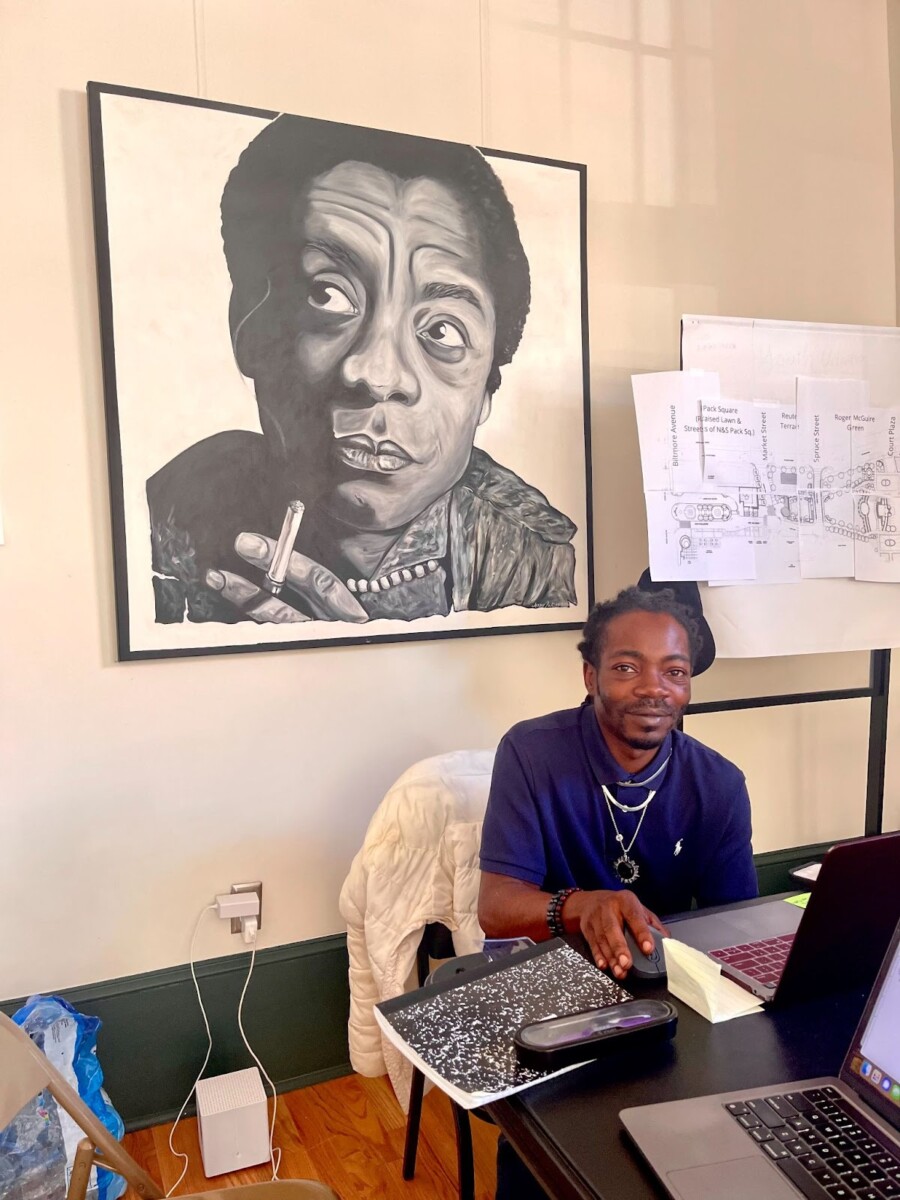 “Thirteen days after Helene first made landfall in the U.S., it is known that at least 230 people died during the storm’s surge, with hundreds of people still unaccounted for,” Angela Dennis and Adam Mahoney reported Thursday for Capital B.
“Thirteen days after Helene first made landfall in the U.S., it is known that at least 230 people died during the storm’s surge, with hundreds of people still unaccounted for,” Angela Dennis and Adam Mahoney reported Thursday for Capital B.
“While the Federal Emergency Management Agency ultimately sent out more than 7,000 employees and thousands of volunteers poured into the region with tons of food, clothes, water, and other supplies, it still took days for aid to reach some people — particularly Black low-income people, the elderly, and those living with disabilities. . . .
“Asheville is about 11.2% Black and Augusta is 60% Black. In Georgia, the voter registration deadline has already passed, and in North Carolina, it is just a day away, on Oct. 11. After storms, communities usually have fewer in-person voting polls, and more mail-in ballots are lost or destroyed. And those who originally planned to vote feel like they won’t have enough time or access to information to cast an educated vote.
“Typically, Black voter participation in North Carolina and Georgia is above the national average for Black voters, but based on a series of studies, there is an expectation that voting in the impacted regions will decline by around 10%. . . . .
“Tomiko Ambrose Murray, a political organizer in Asheville, laid it out plainly.
” ‘We are trying to figure out how to get Black folks to participate in the election; I think there can be a narrative that Black people don’t care about climate change, and that’s just false,’ she said. . . .”
(Photo: Robert Thomas of Asheville, N.C., at the YMI Cultural Center, where he assists in relief efforts as well as voter registration post Hurricane Helene; credit Angela Dennis/Capital B)
- LZ Granderson, Los Angeles Times: Disasters like Helene and Milton test leaders. Trump fails every time
- Eugene Robinson, Washington Post: ‘I can’t even find the right adjective’: Hurricane Milton offers a catastrophic reminder
For decades, California police departments that want to sever ties with officers for misconduct have agreed to let them resign and to keep the bad behavior confidential in order to avoid lawsuits. But as a result, hundreds have landed new jobs in law enforcement with no records of their past misconduct. On “PBS News Weekend,” “John Yang speaks with investigative reporter Katey Rusch. (Credit: PBS/YouTube)
Stories Reveal How Problem Cops Are Simply Shifted
“For decades, California police chiefs and sheriffs have lamented how difficult it is to fire officers and deputies who act with dishonesty or brutality, blaming powerful labor unions and robust employment protections,” Katey Rusch reported Sept.17 for the San Francisco Chronicle.
“What law enforcement leaders have not revealed, and what has remained a secret until now, is how they have repeatedly turned to an under-the-radar method of getting rid of problem officers — one that not only allows the officers to avoid accountability but, often, to quietly move on to other jobs where they are asked to protect the public.
“For years, dozens of California police agencies have executed “clean-record agreements,” clandestine legal settlements that promise to hide the wrongdoing of an officer in exchange for the officer’s guarantee to leave an agency without a fight, an investigation by the San Francisco Chronicle and UC Berkeley’s Investigative Reporting Program found. . . .”
- San Francisco Chronicle: This is the secret system that covers up police misconduct — and ensures problem officers can get hired again (updated Sept. 24)
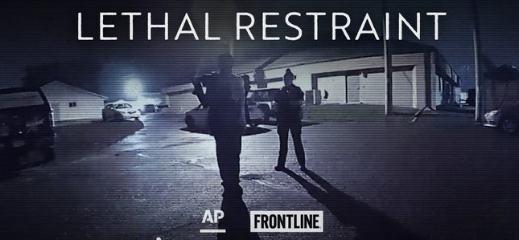
More Than 1,000 Have Died by Wrongful Use of Force
Many more people have died after police subdued them than the American public knows, a continuing Associated Press investigation has concluded.
The series resumed Tuesday, with Ryan J. Foley and John Seewer reporting for the news organization:
An investigation led by The Associated Press found that over a decade, more than 1,000 people died after police subdued them with physical force that is not supposed to be lethal. Explore the full database of cases here.
In hundreds of these encounters, officers broke multiple safety guidelines. Dozens of deaths reveal the risks of injecting sedatives into people restrained by police.
In response to AP’s reporting, a leading policing group has published new guidelines for handling encounters involving what’s known as less-lethal force.
Coates Draws SRO Crowd to New York’s Apollo
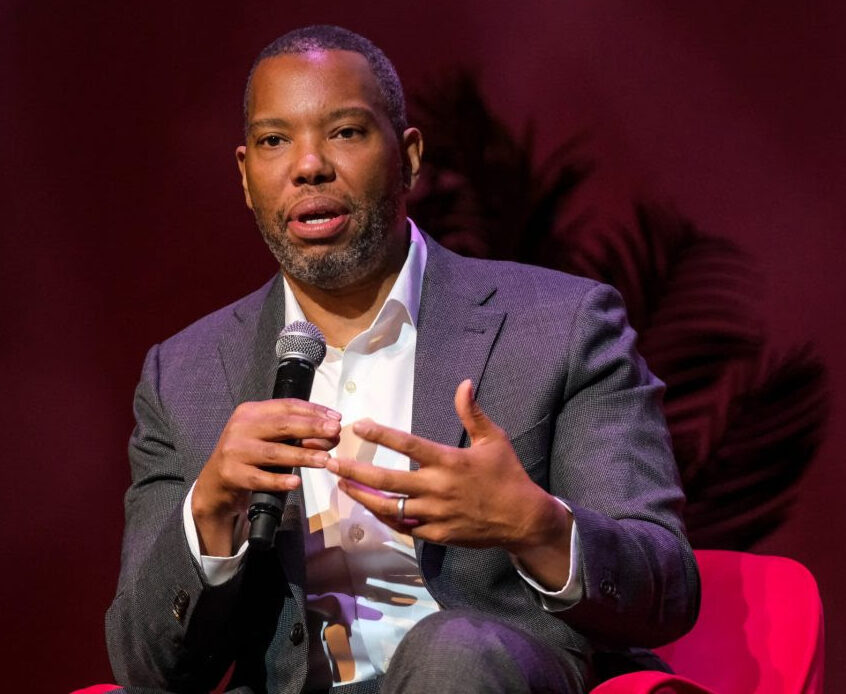 “You wonder how author Ta-Nehisi Coates (pictured, by Laylah Amatullah Barrayn, courtesy of The Apollo) felt sitting on the stage of the Apollo Theater fielding questions from journalist Ayman Mohyeldin,” Herb Boyd wrote Thursday for the New York Amsterdam News. “It should have been him answering a pedestrian, a 125th street regular, who wanted to know why so many people were crowded outside the theater. ‘Who’s performing tonight?’ the man asked. ‘It’s been a long time since I’ve seen this many people here.’
“You wonder how author Ta-Nehisi Coates (pictured, by Laylah Amatullah Barrayn, courtesy of The Apollo) felt sitting on the stage of the Apollo Theater fielding questions from journalist Ayman Mohyeldin,” Herb Boyd wrote Thursday for the New York Amsterdam News. “It should have been him answering a pedestrian, a 125th street regular, who wanted to know why so many people were crowded outside the theater. ‘Who’s performing tonight?’ the man asked. ‘It’s been a long time since I’ve seen this many people here.’
“From the balcony to audience member Carl Dix seated in the front row of the orchestra, the Apollo was packed to SRO capacity. No writer in recent memory has attracted such a large and enthusiastic audience. The Apollo itself must have swooned with memories of James Brown, Aretha Franklin, and the Motown days when the lines wrapped around the block. . . .”
After discussing his Sept. 30 appearance on “CBS Mornings,” “Mohyeldin quickly shifts gears, returning to the book’s format and an earlier section on Coates’s visit to Senegal, which, along with South Carolina and Palestine, are the three stops of his tour. In Senegal, Coates is defined as a person of mixed ancestry by an acquaintance. ‘Look, I understand that Black is in America. I get that you’re Black there, but here you are mixed. That’s how we see most Black Americans,’ is a conversation from the book. Coates was told that being of mixed race in Senegal was seen as beautiful and that many women tried to lighten their skin and straighten their hair. ‘This surprised me,’ he wrote.
“Coates is asked if he sees a correlation between the ability to dehumanize people and the ability to subject them to control. ‘Yes,’ he answers immediately. ‘And I’ll just go ahead of you. I don’t think the United States of America, and I want to be clear about this. I don’t think the United States should provide fighter planes as it’s doing to drop 2000-pound bombs on schools, hospitals.’ There was a loud round of applause. . . .”
- Yirmiyahu Danzig, Forward: I’m a Jew of color. Ta-Nehisi Coates can’t apply U.S. lessons to Israel
- Ezra Klein Show, New York Times: Ta-Nehisi Coates on Israel: I Felt Lied To (podcast)
- Alex Griffing, Mediaite: ‘I Just Don’t Want to Hear’ It: Ta-Nehisi Coates Tells Ezra Klein Why He Didn’t Speak to Mainstream Israelis For Book
- Ruben Navarrette Jr., syndicated: At CBS News, a Journalist Gets in Hot Water for Practicing Journalism
“How Israel’s media crackdown is blocking information from leaving Gaza,” a video report Thursday from DW News by Deutsche Welle, includes comments of Jodie Ginsberg, chief executive of the Committee to Protect Journalists and Rebecca Vincent, director of campaigns for Reporters Without Borders. (Credit: YouTube)
No Accountability for Journalist Deaths in Lebanon
“A year on, there is still no accountability following the October 13, 2023, targeted Israeli attack that killed Issam Abdallah and injured six journalists in southern Lebanon,” Amelia Evans and Zoe Simbolon reported Thursday for the Committee to Protect Journalists.
“Less than a week into the Israel-Gaza war, at 6:02 p.m. on October 13, 2023, the Israeli military fired two tank shells 37 seconds apart into south Lebanon. The military’s target? Seven journalists standing on a hilltop around a mile from the closest hostilities, wearing clearly marked ‘Press’ vests and reporting next to a car marked ‘TV.’
“The Israeli attack instantly killed Reuters’ Issam Abdallah, a veteran video journalist with extensive experience covering conflict in his native Lebanon, as well as in Syria, Iraq, and Ukraine. Agence France-Presse (AFP) photojournalist Christina Assi, also from Lebanon, sustained injuries resulting in the amputation of her right leg. Five other journalists were also wounded: AFP’s Dylan Collins, from the United States; Al Jazeera’s Carmen Joukhadar and Elie Brakhya, also from Lebanon; and Reuters’ Thaer Al-Sudani and Maher Nazeh, from Iraq.
“In March 2024, an investigation by the United Nations Interim Force in Lebanon concluded that an Israeli tank targeted ‘clearly identifiable’ journalists in violation of international law, according to Reuters’ review of the investigation, which has not been made public. Four additional investigations — by AFP, Amnesty International, Human Rights Watch, and Reuters — all independently arrived at the same conclusion: that Israel conducted a deliberate attack on the journalists. A deliberate attack on civilians constitutes a war crime under international law.
“Yet, a year later, Israel still has not confirmed if it has even completed a preliminary investigation into the attack. The North America Media Desk of the Israel Defense Forces (IDF) told CPJ in an email that the military used tank and artillery fire on October 13 to prevent a suspected ‘terrorist infiltration,’ and the incident was ‘under review.’ Israel has not released information about the identities of the officials who authorized or conducted the strike, leaving the survivors with more questions than answers about the attack that upended their lives and impeded their work. . . .”
- Committee to Protect Journalists: One year and climbing: Israel responsible for record journalist death toll (Oct. 4)
- Amy Goodman and Nermeen Shaikh, “Democracy Now!”: Motaz Azaiza, Acclaimed Journalist from Gaza, on Photographing War & Making “Art from the Pain”
- Reporters Without Borders: One year in Gaza: how Israel orchestrated a media blackout on a region at war
KTLA in Los Angeles covered Saturday’s celebration of life for Warren Wilson, a former KTLA reporter, at L.A.’s First African Methodist Episcopal Church. (Credit: YouTube)
Warren Wilson, Pioneering L.A. Journalist, Dies at 90
“Warren Wilson, who in 1969 became one of the first Black television journalists hired in Los Angeles, and who used the trust he accumulated in his work to help fugitives surrender safely to the police, died on Sept. 27 in Oxnard, Calif. He was 90,” Richard Sandomir reported Thursday for The New York Times.
“His son Stanley, a former news and documentary producer at CNN, confirmed the death, at an assisted living facility, but did not specify the cause.”
The Los Angeles Sentinel, part of the Black press, called Wilson “A trailblazer who broke the color barrier in every facet of American journalism,” saying Wilson “worked 40 years in radio, wire services, and television, and covered every major news story in Southern California.”
Sandomir continued, “Over more than 40 years as a reporter for wire services, a local radio station and the television stations KNBC and KTLA, Mr. Wilson covered the riots in the Watts neighborhood of Los Angeles, Senator Robert F. Kennedy’s assassination, the Hillside Strangler murders and the O.J. Simpson trial.
“But over more than three decades, he also became involved in the lives of 22 fugitives who decided it was safer to surrender to him than to be abused, or worse, by the authorities during an arrest. Their surrenders were often shown on Mr. Wilson’s TV reports.”
Clara Harter, writing in the Los Angeles Times, attributed his status as an intermediary to “the deep trust he established in communities of color.“
“People knew that if Warren Wilson was involved, that there would not be an incident where a person would be mistreated,” L.A. City Councilman Bernard Parks, who saw Wilson on crime scenes when he was chief of police, told The Times in 2005.While some people criticized Wilson for becoming too personally involved in criminal cases, Wilson always stood by his approach and argued that it saved lives.
“ ‘I guess I can identify with the underdog because of what I’ve had to go through as a Black man working in a white world,’ Wilson told The Times in 1993. “I take some pride in thinking that maybe someone — a suspect or a police officer — stayed alive because of all this.”
“The journalist said he inherited his strong moral compass, including a deep-seated sense of equality, from his father, who was once was once assaulted by members of the Ku Klux Klan in North Carolina. . . .”
Short Takes
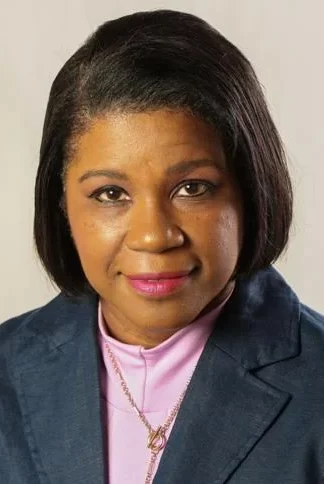 Kathy Chaney (pictured), who has been executive editor of web-based YR Media, where she supervised a national newsroom that targets younger audiences; deputy managing editor at the Chicago Sun-Times; and vice president/print of the National Association of Black Journalists, became the first African American and female executive editor in the history of Lee Enterprises’ Times of Northwest Indiana on Oct. 1. “I’m excited to be working with a team who understands that community journalism is the core mission of everything,” Chaney said. “It’s always been the driving force throughout my career. My immediate goals will be to strengthen the bonds I’m forming in the newsroom and build strong relationships in the community.” NABJ statement
Kathy Chaney (pictured), who has been executive editor of web-based YR Media, where she supervised a national newsroom that targets younger audiences; deputy managing editor at the Chicago Sun-Times; and vice president/print of the National Association of Black Journalists, became the first African American and female executive editor in the history of Lee Enterprises’ Times of Northwest Indiana on Oct. 1. “I’m excited to be working with a team who understands that community journalism is the core mission of everything,” Chaney said. “It’s always been the driving force throughout my career. My immediate goals will be to strengthen the bonds I’m forming in the newsroom and build strong relationships in the community.” NABJ statement
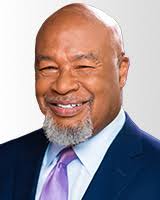 Anthony Wilson (pictured), “beloved weekend anchor” at WTVD-TV in Raleigh, N.C., signed off on the weekend morning show Oct. 6 for the final time — thanking his family, colleagues, and the ABC11 viewers, the station reported. Wilson is the force behind the student projects at the National Association of Black Journalists. “I’m not ruling out special projects like documentaries or podcasts as a possible next chapter, so stay tuned!” he said.
Anthony Wilson (pictured), “beloved weekend anchor” at WTVD-TV in Raleigh, N.C., signed off on the weekend morning show Oct. 6 for the final time — thanking his family, colleagues, and the ABC11 viewers, the station reported. Wilson is the force behind the student projects at the National Association of Black Journalists. “I’m not ruling out special projects like documentaries or podcasts as a possible next chapter, so stay tuned!” he said.
- “Racism is a fundamental determinant of health inequities among racial and ethnic groups and is understudied among adolescents,” reported a study Thursday in the Morbidity and Mortality Report of the Centers for Disease Control and Prevention. “Racism in the school setting is experienced by high school students attending public and private schools and continues to disproportionately affect students of color. Students who reported experiencing racism had a higher prevalence of indicators of poor mental health, suicide risk, and substance use. Schools can incorporate policies and practices to prevent unfair treatment on the basis of race and ethnicity and offer resources to help students cope with these experiences.”
- . . . Meanwhile, “A growing number of U.S. institutes created to explore the nexus between racism and health — and the researchers who preside over them — are finding themselves under attack, their missions and funding in peril barely four years after the nation had what many called its ‘racial reckoning,’ ” Akilah Johnson reported Friday for The Washington Post.
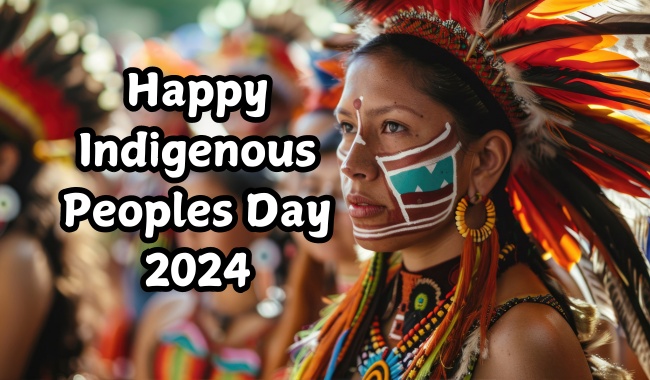
- “While every day is a good day to be Indigenous, each year on the second Monday of October, the United States celebrates Indigenous Peoples Day,” ICT News, formerly Indian Country Today, said Wednesday. It published a running list of events.
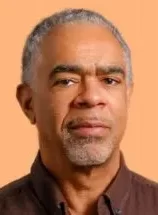 Tony Marcano (pictured) has been hired as managing editor of the California Newsroom, a collaboration among NPR and member stations,” Julian Wyllie reported Sept. 9 for Current. “Marcano succeeds Adriene Hill, who left public media in February to become EP of daily news for Crooked Media. Marcano, who most recently worked as interim managing editor during the search, previously worked as managing editor for LAist. He has also held editorial positions with NPR, the New York Times and the Los Angeles Times.”
Tony Marcano (pictured) has been hired as managing editor of the California Newsroom, a collaboration among NPR and member stations,” Julian Wyllie reported Sept. 9 for Current. “Marcano succeeds Adriene Hill, who left public media in February to become EP of daily news for Crooked Media. Marcano, who most recently worked as interim managing editor during the search, previously worked as managing editor for LAist. He has also held editorial positions with NPR, the New York Times and the Los Angeles Times.”
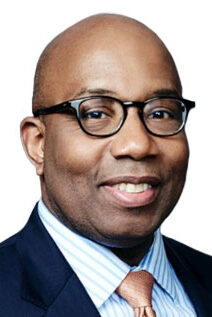 Errol Louis (pictured), NY1 anchor and CNN political analyst, is part of a “collective — a who’s-who of New York journalists, including political writers, editors and columnists” who “are launching the project to vet candidates for higher office, in what they say is an effort to continue the tradition left behind by retreating local media outlets,” Brian Stelter reported Oct. 4 for CNN.
Errol Louis (pictured), NY1 anchor and CNN political analyst, is part of a “collective — a who’s-who of New York journalists, including political writers, editors and columnists” who “are launching the project to vet candidates for higher office, in what they say is an effort to continue the tradition left behind by retreating local media outlets,” Brian Stelter reported Oct. 4 for CNN.
- “In a trial that lasted more than two years, on Sept. 30 a Peruvian court sentenced former military officer Alberto Rivero Valdeavellano to 18 years in prison for the forced disappearance of journalist Jaime Ayala Sulca, which was carried out by those under his command in Ayacucho 40 years ago,” Silvia Higuera reported Oct. 2 for LatAm Journalism Review. “The crime against Ayala is part of the Huanta 84 Case, which also includes the murders of six members of the Evangelical Presbyterian Church of Callqui and the discovery of 50 bodies in the Pucayacu graves. All of these crimes occurred in 1984, one of the most violent times of the internal conflict in Peru. . . “
- “A nearly eight-year dream came true for Colombian journalist Jineth Bedoya Lima when, in June this year, congress passed a law creating a fund to prevent, protect, and assist women journalists who are victims of violence,” Silvia Higuera reported Friday for LatAm Journalism Review. “Its resources — $500,000 U.S. per year for five years, according to the Foundation for Press Freedom — will be used for prevention and research programs.”
- “The Cameroonian government should end its threats to sanction private media journalists who report on the condition and whereabouts of President Paul Biya, 91, who has not been seen publicly for over a month and has missed scheduled international engagements,” the Committee to Protect Journalists said on Thursday.
- “Authorities in Burkina Faso on Monday suspended Voice of America for three months over comments made by one of the network’s journalists,” Liam Scott reported Tuesday, updated Wednesday, for the Voice of America. “The junta also temporarily banned local news outlets from using any international media reports, the reports said. Burkina Faso’s superior council for communication, also known as CSC, accused VOA of demoralizing troops in Burkina Faso and nearby Mali in a broadcast on Sept. 19, according to media reports. The interview was later aired by a privately owned local radio station, according to Reuters.”
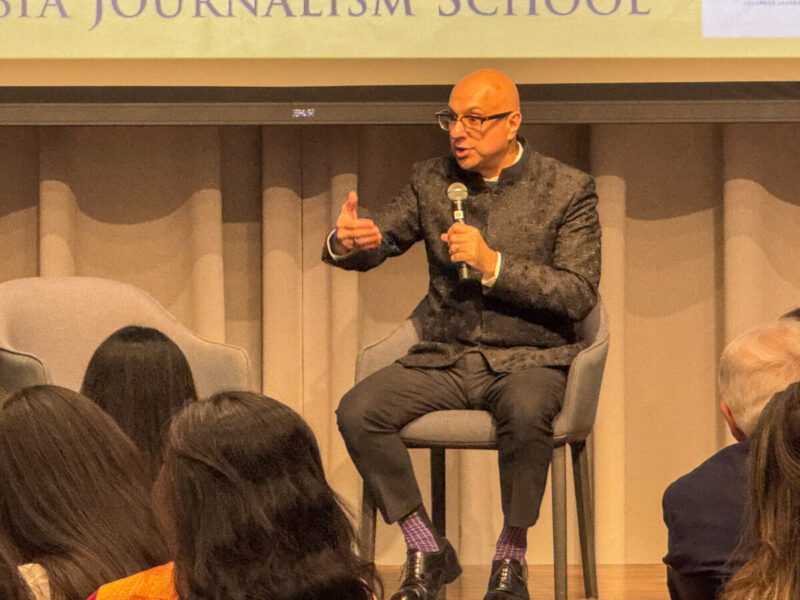
Ali Velshi, MSNBC chief correspondent, delivers his keynote at the gala award reception inside Columbia University’s Joseph D. Jamail Lecture Hall during SAJA’s 30th anniversary celebration on Saturday. “The one thing we have today that we did not have when SAJA started is people in positions of influence,” Velshi said. (Photos by Tolu Olasoji)
South Asian Journalists at 30: Relatively Small, but Diverse, Network-Ready, Watchful of Kamala Harris
By Tolu Olasoji
On Saturday evening at Columbia University in New York, the Joseph D. Jamail Lecture Hall buzzed with energy and color as the South Asian Journalists Association (SAJA) celebrated its 30th anniversary.
Earlier, the World Room — where Pulitzer Prizes are announced — had hosted a vibrant reception, and now, South Asian journalists and friends, most of whom were resplendent in their sarees (spelled saris in the West), salwar kameez and kurtas, filled the hall. At the front of the room stood MSNBC’s chief correspondent, Ali Velshi, himself adorned in a kurta, ready to deliver the keynote.
As Velshi spoke, he embodied both the evening’s celebratory tone and the weight of the moment. “The one thing we have today that we did not have when SAJA started is people in positions of influence,” Velshi remarked. He highlighted how South Asians, once on the margins, now hold key roles “in news organizations, in universities, in corporations across America.
“We can have our imprint, where we can actually speak our truth,” he told the 300 filling the room.
Earlier in the day, Velshi sat across from author Ta-Nehisi Coates for an interview on MSNBC. Coates, in his new book, “The Message,” compares Israel with the Jim Crow-era American South, questioning its foundation after the Holocaust and accusing the state of being built on “ethnocracy” and “apartheid.” It was the basis of a contentious interview on “CBS Mornings” with host Tony Dokoupil, who is Jewish, challenging Coates’ framing.
Velshi didn’t mince words in responding to a question about the lack of diversity in Middle East war coverage. On Coates, he said: “He’s had some b.s. interviews in the last week, [and] I don’t subscribe to that!”
Velshi is able to call out the limitations of mainstream media’s discourse on such thorny issues as the Israel-Hamas war, democracy and the immigrant crisis. His audacity is a testament to the growing influence of South Asians in the media; one of which Velshi says SAJA has been a significant part.
“Back then, it was really a ‘who do I turn to for kinship’” situation, Velshi reflected.
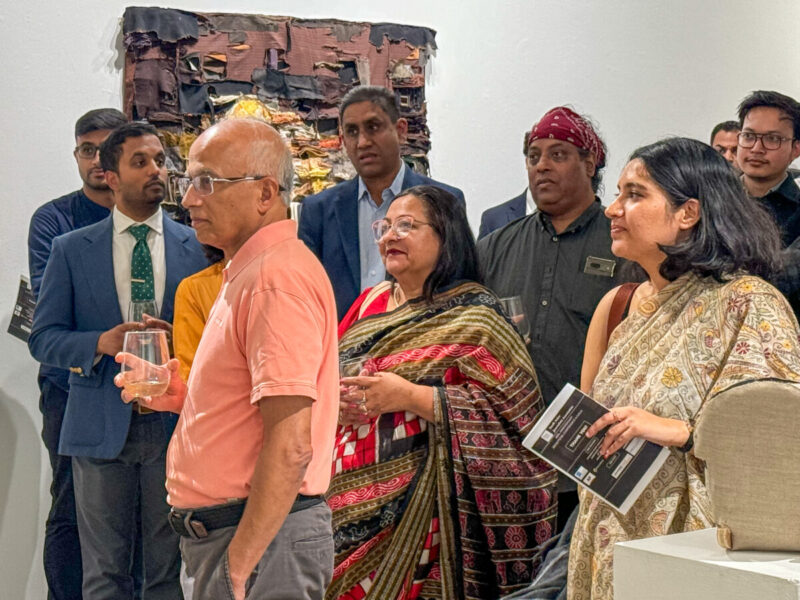
South Asian journalists listen intently at a vibrant reception at Aicon Gallery, an Indian-owned art space in Lower Manhattan. The space showcases modern and contemporary South Asian art.
From its modest beginnings as “samosa-eating meetings,” as co-founder Sree Sreenivasan fondly recalled, SAJA has evolved into a vital network for more than 1,000 South Asian journalists with diverse backgrounds and identities.
A 2022 Pew Research study found that just 3 percent of journalists in the United States are of Asian descent, with South Asians an even smaller fraction of that already limited group.
More than providing kinship, SAJA has continually put its resources to work, ensuring that its members have the opportunities to thrive in a white-dominated industry. Many of the panelists at the convention, for instance, benefited from SAJA’s support through such initiatives as its reporting fellowship, launched after the 2004 Indian Ocean tsunami to enable journalists to cover complex South Asia-related issues often overlooked by mainstream media.
That support has been instrumental in launching the careers of journalists who have since become prominent voices in the United States and elsewhere.
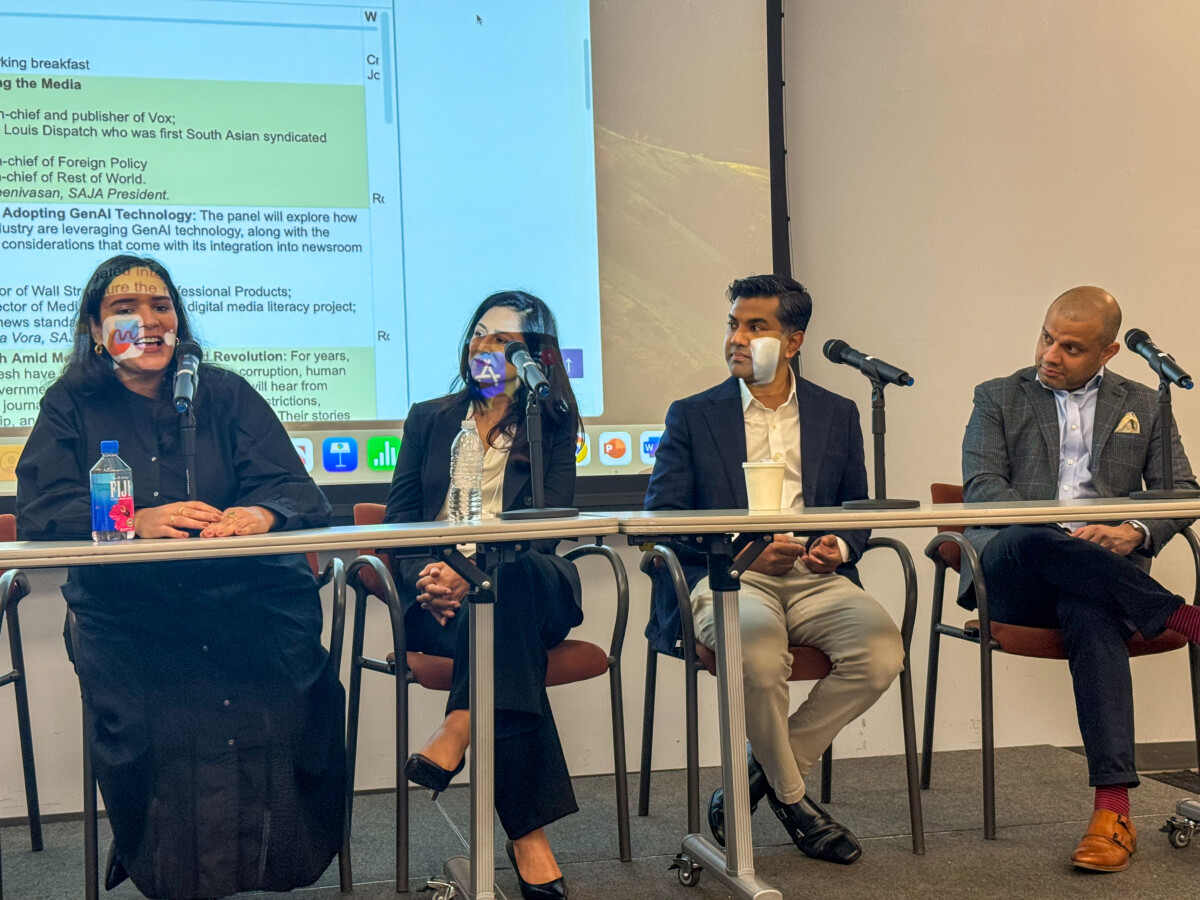 The event’s flagship panel, “South Asians Changing the Media,” underscored this. The panel included (pictured, from left) Swati Sharma, editor-in-chief and publisher of Vox; Aisha Sultan, the first South Asian syndicated columnist at the St. Louis Dispatch; Ravi Agrawal, editor-in-chief of Foreign Policy; and Anup Kaphle, editor-in-chief of Rest of World.
The event’s flagship panel, “South Asians Changing the Media,” underscored this. The panel included (pictured, from left) Swati Sharma, editor-in-chief and publisher of Vox; Aisha Sultan, the first South Asian syndicated columnist at the St. Louis Dispatch; Ravi Agrawal, editor-in-chief of Foreign Policy; and Anup Kaphle, editor-in-chief of Rest of World.
Part of the discussion touched on the personal stories of these journalists and how their journeys were intertwined with the mentorship and support provided by SAJA or someone affiliated with the body.
For instance, Kaphle, a Nepali immigrant, shared how a $1,500 SAJA scholarship and aid from a board member helped him fulfill a childhood dream of becoming a journalist.
“I was sleeping on the couch of one of the SAJA board members all summer, and then the following year, I got another unpaid internship at Forbes, and I had gotten into Columbia Journalism School,” he recalled.
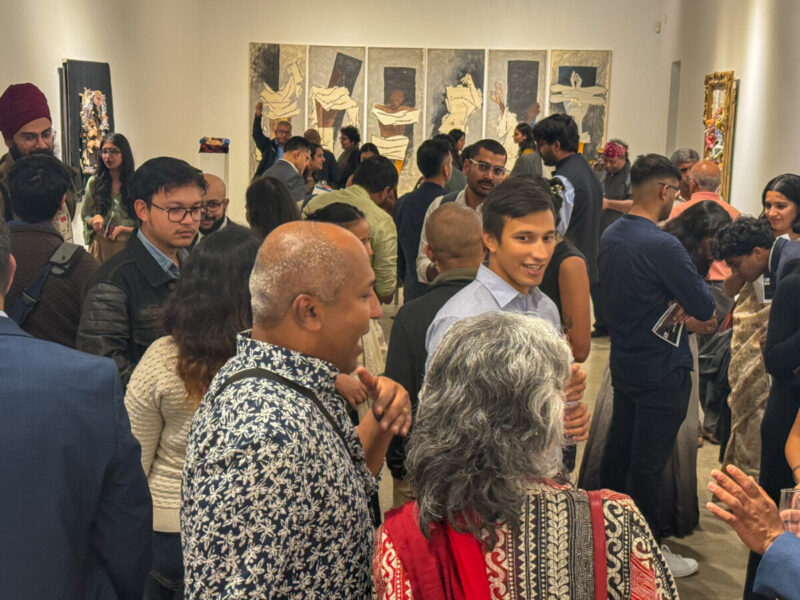
At the art gallery: “Our events are not massive or big, but they’re intimate, and that’s how you make a connection through intimacy, instead of the big convention halls,” said Sovy Azhath. SAJA co-founder Sree Sreenivasan is in foreground at left.
While SAJA might not have the membership numbers of such larger journalists of color organizations as the National Association of Black Journalists, it draws strength from its close-knit community, offering its members invaluable networking opportunities to move up the rung.
“Our events are not massive or big, but they’re intimate, and that’s how you make a connection through intimacy, instead of the big convention halls,” said Sovy Azhath, a former SAJA board member.
“Right from the doors, they are helping out with fellowships,” he added.
The word “networking” echoed throughout the two-day celebration, and felt somewhat central to the event’s design and the organization’s overall goal.
The festivities kicked off with a vibrant reception at Aicon Gallery, an Indian-owned art space in Lower Manhattan. The space showcases modern and contemporary South Asian art, creating a fitting backdrop for the evening as the journalists and convention guests filtered in from within the country and outside.
The following day featured a mix of activities at City University of New York, where panels were held, and Columbia, where the event closed out with an award gala. A significant number of board members and attendees have ties to these institutions, holding or having held significant roles within them, including President Sreenivasan, who was a dean at Columbia Journalism School. He spoke fondly of the support from individuals and sponsors, which included The New York Times, the Associated Press and Newsweek magazine.
In that same spirit, SAJA organized informal networking sessions at CUNY for emerging journalists with editors and seasoned professionals, providing opportunities for “open-ended” networking and career guidance.
“We want you to network, meet people, connect. That’s the idea,” Sreenivasan urged at Friday’s opening reception.
 The event catered to a diversity of South Asian identities. From comic Darrel Ganesh Sukhdeo’s Indo-Caribbean roots, which mirror those of Vice President Kamala Harris, to Houston Landing’s CEO Peter Bhatia (pictured), former editor of the Detroit Free Press and the Oregonian, who humorously referenced his Irish-Indian background, the gathering mocked a persistent issue in American media and its society: the difficulty in grasping identities that fall outside the Black and White binary.
The event catered to a diversity of South Asian identities. From comic Darrel Ganesh Sukhdeo’s Indo-Caribbean roots, which mirror those of Vice President Kamala Harris, to Houston Landing’s CEO Peter Bhatia (pictured), former editor of the Detroit Free Press and the Oregonian, who humorously referenced his Irish-Indian background, the gathering mocked a persistent issue in American media and its society: the difficulty in grasping identities that fall outside the Black and White binary.
This issue has again gained national prominence as Harris, atop the Democrats’ ticket for the presidential election, has been accused of elevating her ‘Blackness’ over her South Asian heritage for the optics.
“Isn’t just existing enough?” Deepa Shivaram, NPR’s White House correspondent, asked on SAJA’s 2024 election panel.
“Is there some measure? Is her talking about her mother when she was younger and like, does that not count? Does her childhood not count?” Harris’ mother, Shyamala Gopalan Harris, was a biomedical scientist who had come to the United States from India to study.
Author Prachi Gupta weighed in: “I think that question is sort of lumping everybody into one identity and being like, why is there something about our identity where we’re not proud.”
Shanelle Kaul, a CBS News reporter born in Canada to South Asian parents, noted that Harris’ oft-told story of being inspired to become a prosecutor after protecting a high school friend from an abusive home indeed took place in Montreal. “So many friends and family from Canada have reached out to me, saying, “How come she never talks about Canada?”
Kaul pointed out that campaign demands often dictate messaging, especially with President Biden opting out of his re-election bid late into the campaign season, leaving Harris less time to shape her own narrative. “The goal is to get elected for each of these people,” she said.
The concept of identity is tricky, yet despite these complexities, a palpable sense of pride filled the room. Three South Asian women — Shivaram, Gupta and Kaul — each deeply involved in covering the election — spoke about the significance of their front-row seats in a historic moment. Shivaram highlighted the importance of bringing context and clarity to her reporting on Harris, while Kaul noted a surge of South Asian visibility in national politics on both sides of the aisle.
Vivek Ramaswamy, the former GOP presidential candidate, former South Carolina Gov. Nikki Haley and Usha Vance, wife of Republican vice presidential candidate J.D. Vance, also represent South Asians in the political arena.
Later at the gala, Velshi emphasized the importance of SAJA members in journalism. “In 2024, what we realize as South Asian journalists is we are foot soldiers for democracy. We are part of the program. Without us, democracy does not flourish,” he said.
“The world is looking to see what happens on Nov. 5, and Americans are looking to you to make sure they have the right information about what to do.”
For Sreenivasan, seeing familiar faces at SAJA’s landmark conference is special, but what feels “extra special” is “seeing people I don’t know, who’ve never met me, never heard of me. That tells me how great SAJA is doing.”
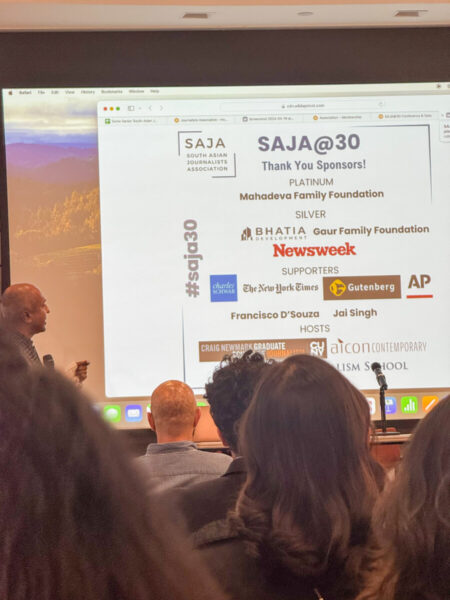
In his address at the awards gala, Sreenivasan (at left, above) said the group stopped counting officially when membership reached a thousand journalists but spoke proudly of the diversity in that number when looking back at the make-up of its founding members three decades ago.
“We were four Indian American first immigrants, all Hindu together, two of us named Sreenivasan, for God’s sake,” he said. “We weren’t thinking of diversity, we could not have imagined what we have built now and all of you have built.”
Now, SAJA has “Pakistani Americans on our board. Think about all the folks who have come out, who are first-generation Indian Americans, and Pakistanis. We also have someone who spoke today as a Fiji Indian. And we have, of course, IndoCaribbeans here in the house.”
As South Asians migrate from stratified societies, many find that the social hierarchies they grew up with are not easily shed in the diaspora. In America, this brings an added layer of complexity, particularly when confronted with both South Asian exceptionalism and the country’s entrenched racial inequities. In a notable reflection of this, South Asian Americans Leading Together (SAALT), a prominent advocacy group, recently announced its dissolution, citing an “identity crisis” shaped by its high-caste origins.
At CUNY, the organization held panels that touched on the plight of Bangladeshi journalists, film screenings on Sri Lanka’s democracy and American Sikhs. There was also space for Ugandan-America Jonah Batambuze’s The BlindianProject.
“We want (SAJA) to be inclusive,” Sreenivasan said.
Tolu Olasoji is a New York-based producer/journalist and member of the New York Association of Black Journalists.
- New York Times: Honors From the South Asian Journalists Association (Oct. 16)
To subscribe at no cost, please send an email to journal-isms+subscribe@groups.io and say who you are.
Facebook users: “Like” “Richard Prince’s Journal-isms” on Facebook.
Follow Richard Prince on Twitter @princeeditor
Richard Prince’s Journal-isms originates from Washington. It began in print before most of us knew what the internet was, and it would like to be referred to as a “column.” Any views expressed in the column are those of the person or organization quoted and not those of any other entity. Send tips, comments and concerns to Richard Prince at journal-isms+owner@
View previous columns (after Feb. 13, 2016).
View previous columns (before Feb. 13, 2016)
- Diversity’s Greatest Hits, 2018 (Jan. 4, 2019)
- Book Notes: Is Taking a Knee Really All That? (Dec. 20, 2018)
- Book Notes: Challenging ’45’ and Proudly Telling the Story (Dec. 18, 2018)
- Book Notes: Get Down With the Legends! (Dec. 11, 2018)
- Journalist Richard Prince w/Joe Madison (Sirius XM, April 18, 2018) (podcast)
- Richard Prince (journalist) (Wikipedia entry)
- February 2018 Podcast: Richard “Dick” Prince on the need for newsroom diversity (Gabriel Greschler, Student Press Law Center, Feb. 26, 2018)
- An advocate for diversity in the media is still pressing for representation, (Courtland Milloy, Washington Post, Nov. 28, 2017)
- Morgan Global Journalism Review: Journal-isms Journeys On (Aug. 31, 2017)
- Journal-isms’ Richard Prince Wants Your Ideas (FishbowlDC, Feb. 26, 2016)
-
Richard Prince with Charlayne Hunter-Gault, “PBS NewsHour,” “What stagnant diversity means for America’s newsrooms” (Dec. 15, 2015)
- Book Notes: Journalists Follow Their Passions
- Book Notes: Journalists Who Rocked Their World
- Book Notes: Hands Up! Read This!
- Book Notes: New Cosby Bio Looks Like a Best-Seller
- Journo-diversity advocate turns attention to Ezra Klein project (Erik Wemple, Washington Post, March 5, 2014)

